|
|
|
Sort Order |
|
|
|
Items / Page
|
|
|
|
|
|
|
| Srl | Item |
| 1 |
ID:
136941


|
|
|
|
|
| Summary/Abstract |
Drawing from ethnographic work carried out between 2005 and 2007, this article considers the ways in which a women’s network has developed strategies to find meaning around the absences of loved ones, killed or ‘disappeared’ during the decades of conflict in Sri Lanka. For most of these women, the fate of their husbands, brothers, sons and fathers is not known and the lack of answers means that they are unable to fully grieve and find closure. In order to survive, they must find ways to deal with the absent bodies and present memories of those who may never be located and accounted for. These strategies include tree-planting ceremonies carried out as a way of not only remembering and mourning loved ones but also asking questions about how one makes sense of loss and what it means to carry the burden of unanswered absences through everyday life and into the future.
|
|
|
|
|
|
|
|
|
|
|
|
|
|
|
|
| 2 |
ID:
135794


|
|
|
|
|
| Summary/Abstract |
This study aims to explain how adolescents in a rural high school conceptualise school violence. Qualitative data were collected over two two-day periods (24 hours) through child-centred tasks like drawing and the completion of open-ended sentences, informal conversations regarding the given activities, observations documented as visual data (photographs), a research journal, and focus group discussions. In total, four boys and five girls participated in the study. Results of the study indicate that the adolescents (aged 15–17 years) view school violence both as negative, in that it causes harm, and positive, in that it serves as a strategy to ensure order and protection. The adolescents conceptualise violence as interweaving constructs of power, discipline and aggression. Future adolescent-focused interventions regarding violence must include conversations about these nuanced understandings.
|
|
|
|
|
|
|
|
|
|
|
|
|
|
|
|
| 3 |
ID:
135431
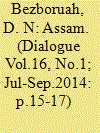

|
|
|
|
|
| Summary/Abstract |
One does not come to such damning conclusions flippantly or in haste. After all, to say that I live in a failed State constitutes a condemnation of myself as well since I am part of a so-called democratic system. But I have discussed the matter with a whole lot of people from different walks of life and they all agree that what we have of Assam today is just a failed State. A State or a country fails not just because the
government has failed but rather because the people have failed themselves and their State or country. Quite obviously, the government must take the bulk of the responsibility for a failed State because all
power is concentrated in the government in our brand of democracy. So when a State gets to be viewed as a failed State the government, and those who run it but fail to ensure good governance, must take the
major share of blame. But the people too cannot escape responsibility for a failed State. I shall come to the issue of how the people fail their State and thereby fail themselves, but it is important to begin at the
beginning.
|
|
|
|
|
|
|
|
|
|
|
|
|
|
|
|
| 4 |
ID:
137029


|
|
|
|
|
| Summary/Abstract |
Many authoritarian regimes selectively provide critical segments of the population with privileged access to goods and services, expecting political support in return. This article is interested in the effects of this regime strategy: Is violent opposition less likely to occur in subnational regions bound to the ruling elite through such patron–client networks? For its empirical analysis, the article makes use of crowdsourcing data on the number and geospatial distribution of fatalities in the Syrian civil war from March 2011 to November 2012. In terms of selective goods provision, the focus is on the electricity sector. Satellite images of the earth at night are used to proxy spatial variations in the public distribution of electricity in times of power shortages. These data are complemented with information from the last Syrian population census of 2004. Estimations from fixed effect logit models lend support to the hypothesis that the risk of violence has been lower in subdistricts that have been favored by the ruling regime in terms of preferential access to material goods. This hypothesis is further corroborated with qualitative evidence from Syrian localities.
|
|
|
|
|
|
|
|
|
|
|
|
|
|
|
|
| 5 |
ID:
135648


|
|
|
|
|
| Summary/Abstract |
First it was Syria, now Iraq and the creation of a Caliphate incorporating parts of Syria and Iraq by ISIS (now simply IS) that will take the West’s eye further off Afghanistan a second time. Earlier, American President Barack Obama’s stunning political statement fixing the deadline for final troop withdrawal from Afghanistan as end-2016, not as widely believed, 2025, contingent upon the signing of the Bilateral Security Agreement was psychologically a negative development. Obama has outlined a new strategy for a new coalition of the willing that will attempt to roll back IS over the next three years. Precious resources will be diverted to fight the new war against the most extreme and violent form of terrorism that has attracted nearly 15,000 foreign Muslim youth.
|
|
|
|
|
|
|
|
|
|
|
|
|
|
|
|
| 6 |
ID:
136093
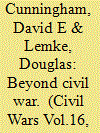

|
|
|
|
|
| Summary/Abstract |
A large quantitative cross-national literature examines why countries are more or less likely to experience civil war. Many of the theories motivating hypotheses about civil war are really arguments about when violence will happen without necessarily explaining why this violence is organized or targets the state. In this article, we examine how variables identified as causing civil war affect other forms of internal violence such as communal conflict, one-sided violence, riots, purges, and coups d'état. We find that factors such as ethnic fractionalization, population, terrain, economic development, and regime type similarly affect different measures of violence. We suggest two avenues for further research – expanding beyond civil war to study determinants of violence within countries more broadly and focusing more directly both theoretically and empirically on the specific determinants of civil war.
|
|
|
|
|
|
|
|
|
|
|
|
|
|
|
|
| 7 |
ID:
135954


|
|
|
|
|
| Summary/Abstract |
While United Nations peacekeeping missions were created to keep peace and perform post-conflict activities, since the end of the Cold War peacekeepers are more often deployed to active conflicts. Yet, we know little about their ability to manage ongoing violence. This article provides the first broad empirical examination of UN peacekeeping effectiveness in reducing battlefield violence in civil wars. We analyze how the number of UN peacekeeping personnel deployed influences the amount of battlefield deaths in all civil wars in Africa from 1992 to 2011. The analyses show that increasing numbers of armed military troops are associated with reduced battlefield deaths, while police and observers are not. Considering that the UN is often criticized for ineffectiveness, these results have important implications: if appropriately composed, UN peacekeeping missions reduce violent conflict.
|
|
|
|
|
|
|
|
|
|
|
|
|
|
|
|
| 8 |
ID:
136504


|
|
|
|
|
| Summary/Abstract |
Even as protests spread across the Middle East in early 2011, the regime of Bashar al-Assad in Syria appeared immune from the upheaval. Assad had ruled comfortably for over a decade, having replaced his father, Hafez, who himself had held power for the previous three decades. Many pundits argued that Syria’s sturdy police state, which exercised tight control over the country’s people and economy, would survive the Arab Spring undisturbed. Compared with its neighbor Lebanon, Syria looked positively stable. Civil war had torn through Lebanon throughout much of the 1970s and 1980s, and the assassination of former Prime Minister Rafiq Hariri in 2005 had plunged the country into yet more chaos.
|
|
|
|
|
|
|
|
|
|
|
|
|
|
|
|
| 9 |
ID:
136440
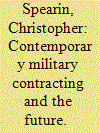

|
|
|
|
|
| Summary/Abstract |
Since the start of the twenty-first century, military contractors such as Blackwater (now named Academi), Kellogg, Brown & Root, and SNC Lavalin have become household names in many countries. The reasons for their prominence vary from case to case. One is notoriety. Particular firms hold contracts valued in the millions if not billions of dollars, and the conduct of some firms has not been beyond reproach in terms of military effectiveness or their observance of human rights. A second reason is reliance. Contractors are needed to keep state military personnel fed and supplied, to maintain their machines, and in some cases even to protect them. Developed world states especially require them for warring, training, and simply operating given the limited numbers of available national military personnel, the increasing sophistication of military technologies, and the political ramifications of applying state forces overseas. In many states, contractors have therefore become part of the total national force. Yet another reason pertains to dedication and sacrifice. Many firms suffered significant levels of casualties during the long-term interventions in Iraq and Afghanistan. Thousands of contracted personnel have provided continuity over the long haul in often austere and intemperate conditions. All of this points to the considerable depth and scope of contractor involvement, arguably unprecedented in recent decades if not centuries. It also stands at odds with traditional conceptions of expensive state security sectors and their capabilities and responsibilities to manage and apply violence.
|
|
|
|
|
|
|
|
|
|
|
|
|
|
|
|
| 10 |
ID:
134234


|
|
|
|
|
| Summary/Abstract |
On a single day in July, when ambient tensions escalated, Palestinian militants fired more than 180 rockets into Israel, and the Israelis launched airstrikes against towns throughout the Gaza Strip. Dozens of Palestinians, most of them civilians, were killed. The order of daily urban life was disrupted, yet again, by warfare.
|
|
|
|
|
|
|
|
|
|
|
|
|
|
|
|
| 11 |
ID:
136513
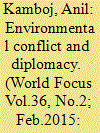

|
|
|
|
|
| Summary/Abstract |
As the global population continues to rise, and the demand for resources continues to grow, there is significant potential for conflicts over natural resources to intensify in the coming decades. At least eighteen violent conflicts have been fuelled by the exploitation of natural resources since 1990. Recent research suggests that over the last sixty years at least forty per cent of all intrastate conflicts have a link to natural resources. Civil wars such as those in Liberia, Angola and the Democratic Republic of Congo have centred on "high-value" resources like timber, diamonds, GOLD, minerals and oil. Some conflicts have involved to control scarce resources such as fertile land and water.
|
|
|
|
|
|
|
|
|
|
|
|
|
|
|
|
| 12 |
ID:
136867


|
|
|
|
|
| Summary/Abstract |
The challenge of violent radicalization is an important part of (the Prevent pillar) of the 2005 EU Counter-terrorism Strategy and is specifically dealt with in the 2005 EU Strategy for Combating Radicalisation and Recruitment to Terrorism. This article assesses the EU counter-radicalization approach by comparing the above mentioned strategies and other policy documents to theoretical notions on radicalization and counter radicalization. It focuses on the comprehensiveness, implementation and consistency of the EU policies that aim to prevent individuals from turning to violence, while halting the emergence of the next generation of terrorists.
|
|
|
|
|
|
|
|
|
|
|
|
|
|
|
|
| 13 |
ID:
134989
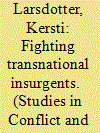

|
|
|
|
|
| Summary/Abstract |
Transnational insurgents are a common feature of contemporary wars, but research on how to address this problem is still scarce. This article examines the South African Defence Force's (SADF) counterinsurgency against Namibian transnational insurgents. It concludes that the South African forces focused a large amount of their efforts outside the borders of Namibia. Highly coercive operations in Angola and Zambia created the space for hearts and minds activities in Namibia, as well as forcing neighboring states to end their support for the insurgents. Although the war in Namibia is somewhat different from contemporary wars, SADF's cross-border strategy gives us some important insights into the regional dynamics of civil wars.
|
|
|
|
|
|
|
|
|
|
|
|
|
|
|
|
| 14 |
ID:
134983
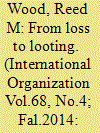

|
|
|
|
|
| Summary/Abstract |
Research into the causes of civilian abuse during civil conflict has increased significantly in recent years, yet the mechanisms responsible for changes in actors' tactics remain poorly understood. I investigate how the outcomes of discrete conflict interactions influence subsequent patterns of rebel violence against civilians. Two competing logics suggest opposite influences of material loss on violence. A stylized model of rebel-civilian bargaining illustrates how acute resource demands resulting from recent severe conflict losses may incentivize insurgent violence and predation. I also identify several factors that might condition this relationship. I evaluate hypotheses based on these expectations by first analyzing the behaviors of the Lord's Resistance Army using subnational conflict data and then analyzing a cross-sectional sample of post–Cold War African insurgencies. Results from both the micro- and macrolevel analyses suggest that rising battlefield costs incentivize attacks on civilians in the period immediately following the accrual of losses. However, group-level factors such as effective control over territory and the sources of rebel financing condition this relationship. The findings suggest potential benefits from examining the interaction of strategic conditions and more static organizational characteristics in explaining temporal and geographic variation in rebel violence.
|
|
|
|
|
|
|
|
|
|
|
|
|
|
|
|
| 15 |
ID:
136857


|
|
|
|
|
| Summary/Abstract |
Jabhat-al-Nusra is successfully undermining the creation of a moderate Sunni ground force in Syria, which is critical for defeating the Islamic States. Columb Strack analyses data showing how the group has made gains towards establishing its own caliphate.
|
|
|
|
|
|
|
|
|
|
|
|
|
|
|
|
| 16 |
ID:
135213


|
|
|
|
|
| Summary/Abstract |
WHEREVER ONE looks these days, crises, conflicts and chaos seem to rule. From Tripoli to Tokyo, from Kiev to Caracas, the pace of violence appears to be accelerating. “Looking back over my more than half a century in intelligence,” the director of national intelligence, James Clapper, testified earlier this year, “I have not experienced a time when we’ve been beset by more crises and threats around the globe.
|
|
|
|
|
|
|
|
|
|
|
|
|
|
|
|
| 17 |
ID:
135176
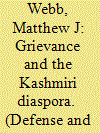

|
|
|
|
|
| Summary/Abstract |
Grievance theories that emphasize injustice as the primary cause of secessionist violence offer valuable insights into the motivations of sponsors and participants. However, they face a difficulty in explaining the participation and support of geographically dispersed populations of co-ethnics (diaspora) that is not shared by rival theories that instead emphasize self-interest. This article uses the Kashmiri diaspora in Britain to examine how appeal to nationalist factors of shared identity, mutual sympathy and common understandings might allow grievance theories to effectively explain diaspora support. It concludes that, while a hybrid grievance-nationalist model might offer a more accurate and nuanced explanatory account of secessionist violence, it does so at the cost of conceptual clarity. Finally, the article addresses the implications for states and strategies to reduce the mobilization of diaspora in order to deny secessionists’ valuable assistance.
|
|
|
|
|
|
|
|
|
|
|
|
|
|
|
|
| 18 |
ID:
134450


|
|
|
|
|
| Summary/Abstract |
Existing research on the causes of violent ethnic conflict is characterized by an enduring debate on whether these conflicts are the result of deeply felt grievances or the product of an opportunity structure in which rebellion is an attractive and/or viable option. This article argues that the question of whether incentive- or opportunity-based explanations of conflict have more explanatory power is fundamentally misguided, as conflict is more likely the result of a complex interaction of both. The fact is, however, that there is little generalized knowledge about these interactions. This study aims to fill this gap and applies crisp-set Qualitative Comparative Analysis (QCA) in order to identify constellations of risk factors that are conducive to ethnic conflict. The results demonstrate the explanatory leverage gained by taking causal complexity in the form of risk patterns into account. It takes no more than four different configurations of a total of eight conditions to reliably explain almost two-thirds of all ethnic conflict onsets between 1990 and 2009. Moreover, these four configurations are quasi-sufficient for onset, leading to conflict in 88% of all cases covered. The QCA model generated in this article also fares well in predicting conflicts in-sample and out-of-sample, with the in-sample predictions being more precise than those generated by a simple binary logistic regression.
|
|
|
|
|
|
|
|
|
|
|
|
|
|
|
|
| 19 |
ID:
136672


|
|
|
|
|
| Summary/Abstract |
Although Susilo Bambang Yudhoyono claims that he has stabilized the situadon in Papua, his policies on Papua as a matter of fact. have faced limitations. Papua remains one of the poorer provinces in Indonesia and, under his presidency, Violence and conflicts escalated, while human rights abuse cases continue. These issues served as fertile triggers for the internationalization of Papua, where unresolved problems in Papua have raised the interest of other countries so that they voice their coricern over the mishandling of Papua and place it under the international agenda; This article will observe cases of Papua internationalization and the diplomatic responses and challenges during SBY’s administration. This article argues that the internationalization of the issue Papua’s self—determination is attributed to two factors: continuous internal domestic 'failure' to promote welfare and human in Papua and Indonesia’s 'diplomacy weaknesses.’
|
|
|
|
|
|
|
|
|
|
|
|
|
|
|
|
| 20 |
ID:
136715


|
|
|
|
|
| Summary/Abstract |
Al Qaeda and its rogue stepchild, the Islamic State, are locked in mortal combat. The two are now competing for more than the leadership of the jihadist movement—they are competing for its soul.
|
|
|
|
|
|
|
|
|
|
|
|
|
|
|
|
|
|
|
|
|